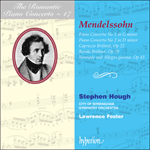
Welcome to Hyperion Records, a British classical label devoted to presenting high-quality recordings of music of all styles and from all periods from the twelfth century to the twenty-first.
Hyperion offers both CDs, and downloads in a number of formats. The site is also available in several languages.
Please use the dropdown buttons to set your preferred options, or use the checkbox to accept the defaults.

| Sir Stephen Hough (piano), City of Birmingham Symphony Orchestra, Lawrence Foster (conductor)» More |

The Rondo is in the key of E flat major. Its light-heartedness is offset by a more formidable and consistent order of virtuoso demand than is found elsewhere in the concertante keyboard works, and the absence of a slow introduction instils a compulsive momentum which is effortlessly maintained from start to finish, aided at several points by a seemingly equestrian accompanying rhythm of paired quaver chords across main beats. The ending is almost too terse, leaving little room for a climactic peroration and vanishing instead with the abruptness of Haydn in mischievous vein. The work seems likely to have appealed to its dedicatee, whose own concerto output was influenced by Beethoven and Schubert and in turn informed Mendelssohn’s style. The Rondo Brillant was composed in 1834.
from notes by Francis Pott © 1997
extrait des notes rédigées par Francis Pott © 1997
Français: Hyperion Records Ltd
Das Rondo steht in der Tonart Es-Dur. Seine Unbeschwertheit wird durch einen beachtlichen und durchgängigen Anspruch auf Virtuosität wettgemacht, der sich an keiner anderen Stelle der concertante-Klavierwerke findet. Außerdem flößt das Fehlen eines langsamen Einleitungsteils ein zwanghaftes Element ein, das ohne Anstrengung durchgängig aufrechterhalten und an mehreren Stellen durch einen Reiterrhythmus von gepaarten Achtelakkorden über den Hauptbetonungen gestützt wird. Das Ende fällt fast zu knapp aus, läßt wenig Raum für eine Klimax im Schlußteil, entfleucht stattdessen in Haydn’scher, verschmitzter Manier vollkommen unvermittelt.
Das Werk scheint den Empfänger der Widmung, dessen eigener Kompositionsstil von Beethoven und Schubert beeinfluß wurde und der seinerseits Mendelssohns Stil nährte, angesprochen zu haben. Das Rondo Brillant wurde 1834 komponiert.
aus dem Begleittext von Francis Pott © 1997
Deutsch: Inge Schneider
 Mendelssohn: Piano Concertos Mendelssohn: Piano ConcertosThis disc brings together, for the first time to our knowledge, all of Mendelssohn’s published works for piano and orchestra, and in performances from the Gramophone Award-winning team of Sir Stephen Hough, the City of Birmingham Symphony Orchestr ...» More |

